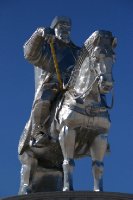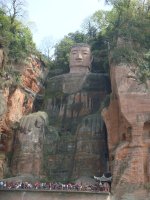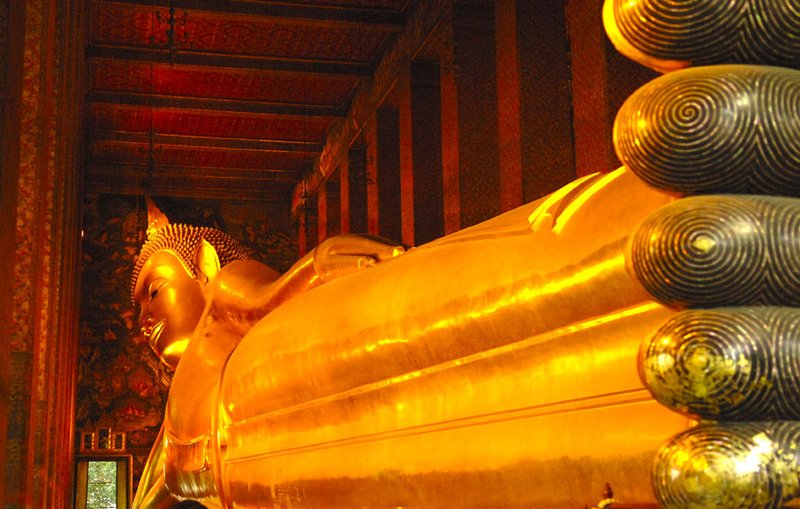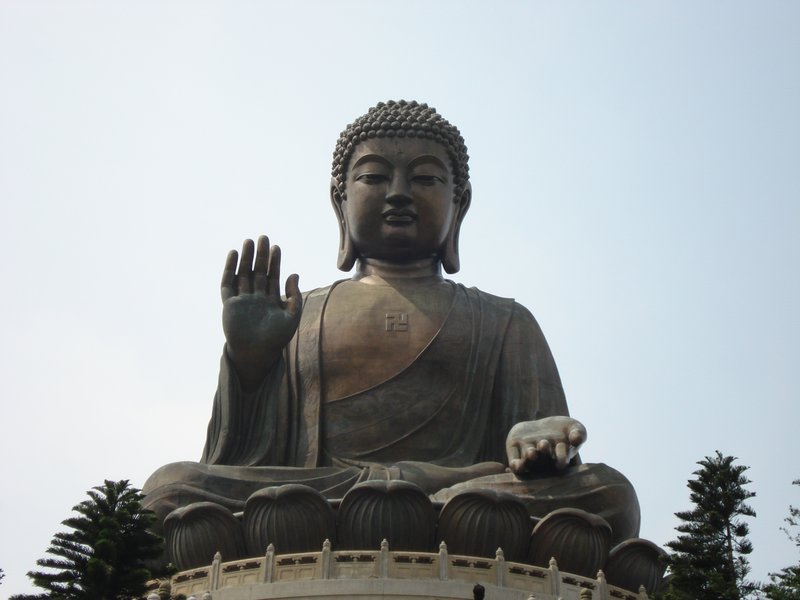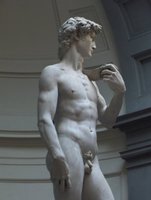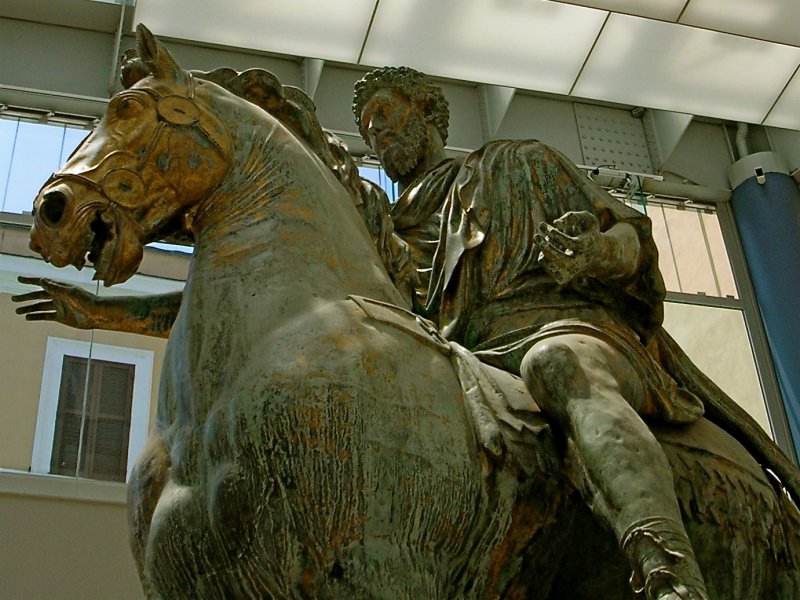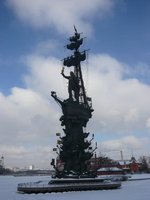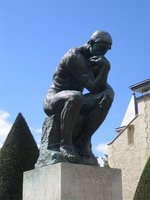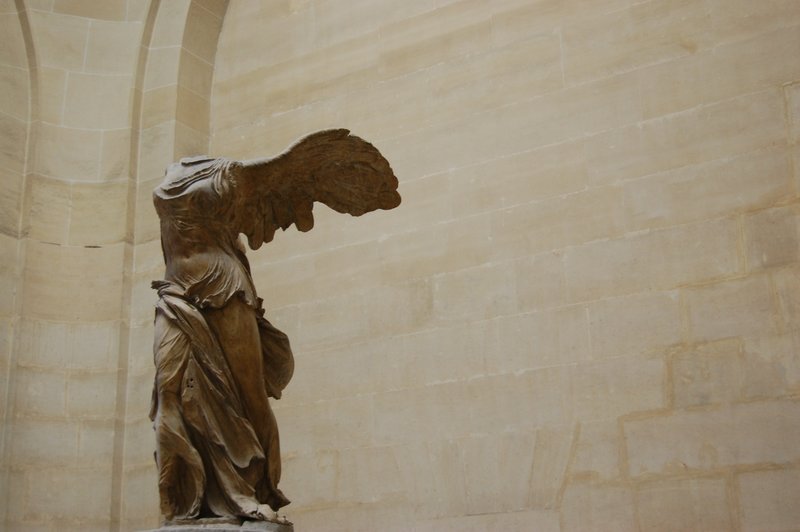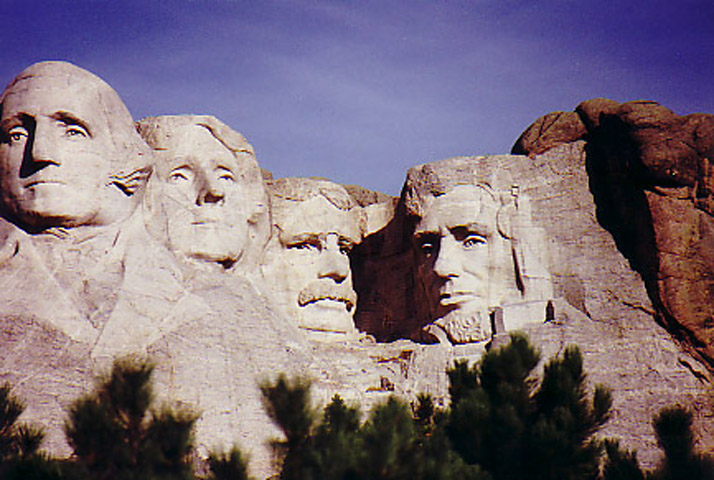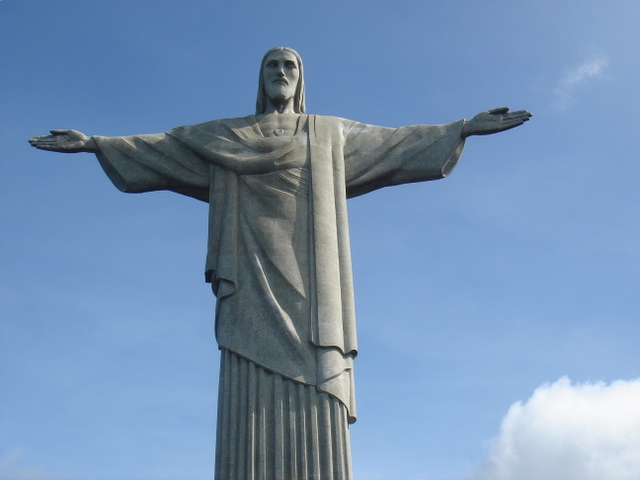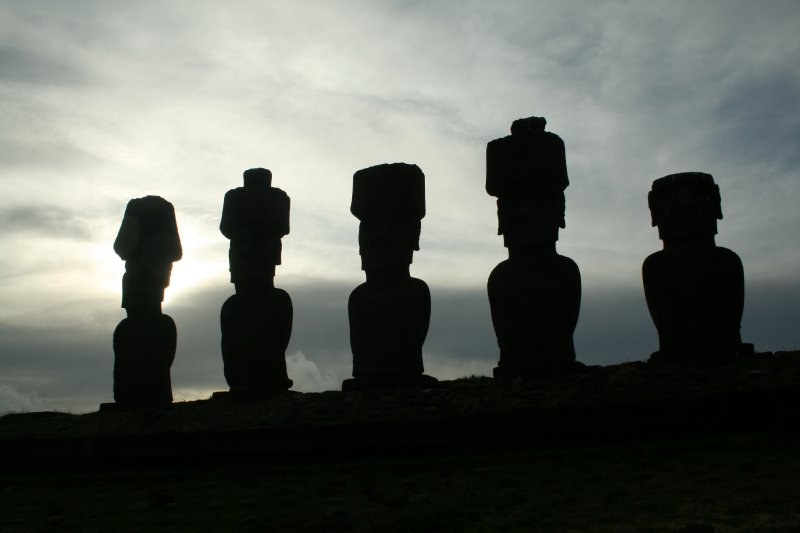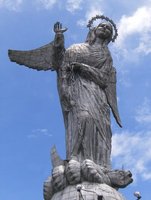Famous Statues
Travel Guide General Guides Famous Landmarks Famous Statues
Introduction
Statues have been erected all over the world for various reasons, and in all sizes. Some were placed for religious reasons, some to commemorate historical events, some to the glory of the ruler of the country, while others just have an artistical origin.
Over the years, statues have become iconic landmarks of the cities where they stand. New York would not be complete without the Statue of Liberty, and the image of Christ the Redeemer overlooking the city of Rio de Janeiro is printed in everybody's mind.
Unfortunately a couple of the most famous statues no longer exist; think of the Colossus of Rhodes, or more recently the Buddhas of Bamiyan which were blown up by the Taliban. Nevertheless the list of famous statues is still impressive.
Africa
Sphinx
- Location: near the Pyramids of Giza, Egypt
- Erected: unknown
- Height: 20 metres
The Sphinx that stands near the pyramids at Giza is the most famous statue of a Sphinx. There are still a lot of mysteries surrounding the statue. There are several theories about the age of the statue, but the most Egyptologists date it back to the 4th dynasty, pre-dating the pyramids. Other evidence suggests an even earlier date, with some scientists claiming that it dates from around 10,000 AD, based on the erosion of the used material. There are also questions about the shape of the Sphinx, as the face is not in proportion with that of the body. Some people suggests that it once was a statue of a giant lion, which was reshaped into a Sphinx. And last but not least, there is the story of the hidden chambers that might lie beneath the sphinx.
Asia
Genghis Khan Statue
- Location: Tsonjin Boldog, Mongolia
- Erected: between 2008
- Height: 40 metres
The Genghis Khan Equestrian Statue at Tsonjin Boldog on the bank of the Tuul River, located 54 kilometers east of the Mongolian capital Ulan bator is part of the Genghis Khan Statue Complex. The statue is 40 metres high and represents Genghis Khan riding on horseback. Tsonjin Boldog is the location, where according to the legend he found a golden whip. Visitors can walk to the head of the horse through its chest and neck of the horse, where you can have panoramic views of the surroundings. Beneath the Statue Complex is a visitor centre which is 10 metres tall, with 36 columns representing the 36 khans from Genghis to Ligdan Khan.
Leshan Giant Buddha
- Erected: between 731 and 803 A.D.
- Height: 71 metres
The Leshan Giant Buddha a statue that is carved out of a cliff that lies at the confluence of the Minjiang, Dadu and Qingyi rivers in Sichuan province in China, just south of the city of Leshan. The stone sculpture faces Mount Emei. This whole area was listed as an UNESCO world heritage site in 1996. It is the largest carved stone Buddha in the world and at the time of its construction it was the tallest statue in the world. From top to bottom it is 71 metres, and at the shoulders it’s 28 metres wide. Due to the pollution coming from nearby factories and the city, the old statue has suffered mainly superficial damage. Luckily it was not damaged during the Sichuan earthquake on May 12, 2008.
Mansudae Grand Monument
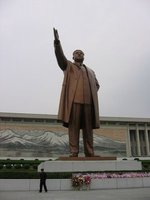
He will show you the (wrong) way
© Utrecht
- Location: Pyongyang, North Korea
- Erected: 1972
- Height: 20 metres
There are many statues and even more portraits of Kim Il Sung then you could ever imagine, but the best known and the biggest is the official Mansudae Grand Monument with a much larger than life statue of the Great Leader. The bronze statue was erected in 1972 along with the neighboring museum, in honor of President Kim's sixtieth birthday. The statue measures around 20 metres and in the back is a 70-metre wide mosaic of Mount Paektu. Literally every visitor to the country will pay a visit to the statue and you are expected to pay your respects by leaving flowers at his feet. If you arrive by air, this will be the first stop on your way to your hotel. No one just drives by the first time!
Murugan
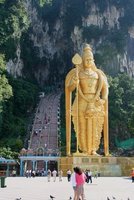
Batu Caves
© Hien
- Location: outskirts of Kuala Lumpur, Malaysia
- Erected: 2006
- Height: 42.7 metres
The Batu Caves are a series of caves inside a limestone hill, 13 kilometres north of Kuala Lumpur city centre, at the suburb of Batu Caves. Inside the hill, there are a number of caves and temples that are open to the public. Outside of the main cave stands the statue of Lord Murugan (Tamil: முருகன்), a popular Hindu deity amongst Tamil Hindus and the most important deity to be worshiped at the temple cave.
The statue is made of reinforced concrete and around 300 litres of gold paint, and took three years to complete. The temple itself was founded in 1892 and is host to the annual Thaipusam festival celebrated in the Tamil month of Thai (between late January and early February). A gathering of about 1.5 million pilgrims during the Thaipusam festival makes it one of the largest gatherings in the world.
Reclining Buddha
The Reclining Buddha is the most famous and largest statue that can be found in Wat Phra Chetuphon Vimolmangklararm Rajwaramahaviharn temple complex, which is more familiar under the much shorter name of Wat Pho. The complex houses over a thousand images of Buddha and is considered to be the birthplace of the traditional Thai Massage. The statue of the reclining Buddha is painted with gold plating. The soles of the feet are decorated with 108 auspicious signs of the Buddha made out of mother of pearl in Thai and Chinese styles.
Spring Temple Buddha
- Location: Lushan, Henan, China
- Erected: 2002
- Height: 128 metres (statue and lotus throne), 153 metres (including the pedestal/building)
The Spring Temple Buddha (鲁山大佛 Lǔshān Dàfó) in China is the tallest statue in the world. It was built as China's answer to plans to erect a 152-metre tall Maitreya Buddha in India, which is still only in the initial stages of building. The monument will become even higher as the top of the mountain on which the monument is situated, is being reshaped to add two more pedestals under the already existing pedestal of 25 metres. The statue gets its name from the nearby Tianrui hot spring, which is famous in the area for its warm water with healing properties.
Tian Tan Buddha
- Location: Ngong Ping, Lantau Island, Hong Kong
- Erected: 1993
- Height: 38 metres
The huge bronze statue is of a sitting Buddha, built on top of a hill near the Po Lin monastery. The name Tian Tan Buddha came from the base of the statue which is a model of the Altar of Heaven of Tian Tan, the Temple of Heaven found in Beijing. Under the Buddha are three floors containing the the Hall of Universe, the Hall of Benevolent Merit, and the Hall of Remembrance. It is claimed that some of the cremated remains of Buddha are located here. Surrounding the buddha are six statues of other gods, giving praise to Buddha. Visitors can climb the 268 steps that lead up to the statue, free of charge.
Europe
Angel of the North
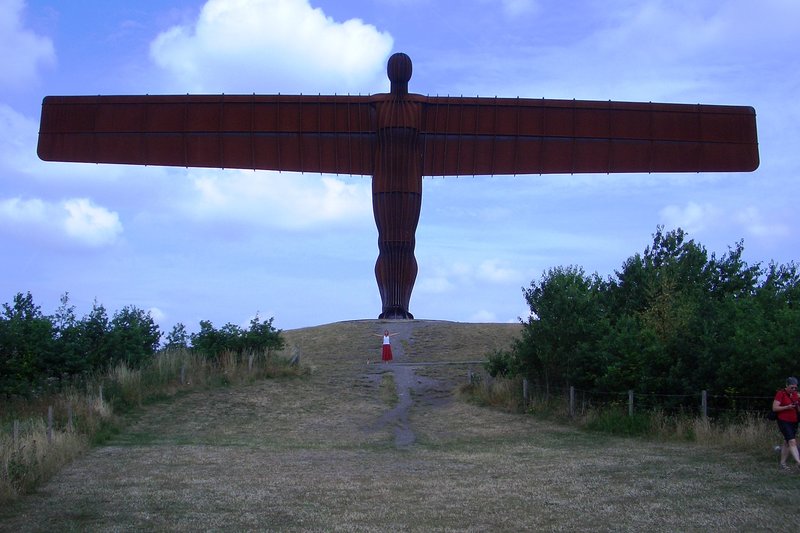
Angel of the North
© baluba
- Location: Gateshead, United Kingdom
- Erected: 1998
- Height: 20 metres
The Angel of the North is a statue that stands 20 metres tall, and 54 metres wide. The statue of the angel is made from steel, and was designed by Antony Gormley. The wings of the angel are not planar but has a 3.5 degrees forward inclination in an attempt by Gormley to create "a sense of embrace". It was build between 1994 and 1998. It stands on a hill just south of Gateshead overlooking the A1 motorway, and Durham road that leads into Gateshead. Because of this exposed location, 661 tons of concrete were used for its foundation in order to anchor the sculpture, thus enabling it to withstand winds of over 160km/hour (100 miles/hour). In the beginning the statue received a lot of criticism, but in the last couple of years, it seems to be more and more accepted by the people, and it is now listed as an icon of England.
David
The statue of David is one of the masterpieces by Italian artist Michelangelo. It depicts David before the fight with Goliath, which was very uncommon, as around that time David was always depicted after the fight. The statue was sculpted out of white marble. Work of the statue has begun in 1464, but several artists failed to complete the statue. It was young Michelangelo, at 26 years of age, who convinced the commissioners that he could complete the statue of David. In 1501 he started working where the others had left off, which was basically some rudimentary shapes and some worked out details of the feet. He worked on the sculpture for 2 years before it was finished. The statue was unveiled at the 8th of September 1504 and placed outside of the Palazzo della Signoria. At the place of this original site, now stands a copy, while the original is located at the Galleria dell' Accademia. It is recommended to reserve tickets (especially during holidays) if you want to avoid a long queue.
Equestrian Statue of Marcus Aurelius
The Equestrian Statue of Marcus Aurelius is an ancient Roman Statue of the Emperor Marcus Aurelius mounted on a horse. The statue is made of Bronze, which makes it more special, as most of the ancient Bronze statues have been melted to be used to make weapons, coins or new statues over the years. The statue of Marcus Aurelius escaped this fate, as it was believed to be a statue of the (first) Christian Emperor Constantine. In the Middle Ages it was one of a few statues that remained on public display in Rome. In the 8th century It stood in the Lateran Palace in Rome, from where it was relocated in 1538 to the Piazza del Campidoglio (Capitoline Hill), when Michelangelo redesigned the square. The original statue was moved indoors to the Capitoline museum in 1990. Where it is displayed in a new addition to the museum. The statue that stands in the square is a copy made in 1898, when it first replaced the original one, when it was removed to be restored.
La Pietà
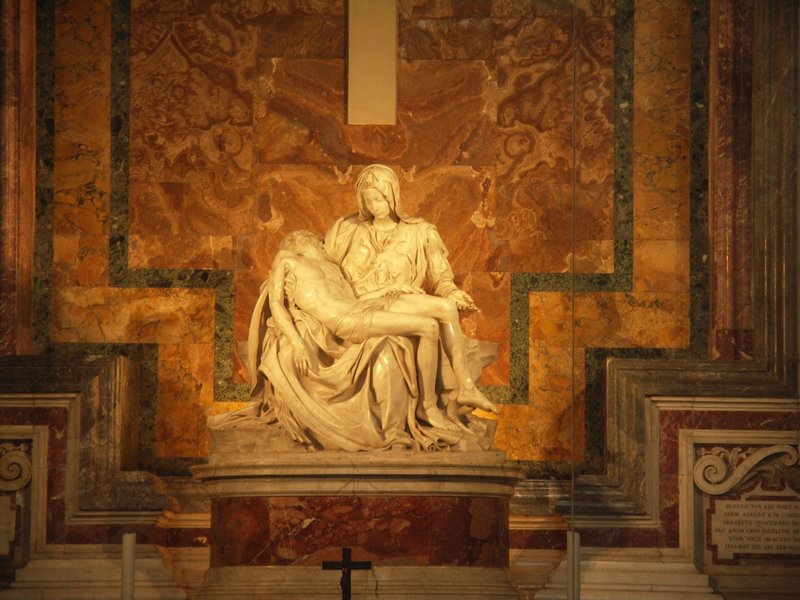
La Pieta
© davidb
- Location: St Peter's Basilica, Vatican City
- Erected: 1499
- Height: 1.74 metres
The only masterpiece ever signed by Michelangelo (on the sash across Mary's breast) La Pietà was one of his earliest works, sculpted on a single marble that he had chosen himself from the pits of Carrara. It depicts a serenely grieving and youthful-looking Virgin Mary, holding her fully grown son on her lap following his crucifixion. The interpretation of the iconographic Christ being mourned by Michelangelo was not without controversial, and opened to several speculations. One way to view it is that the ageless Mary represents incorruptible purity. In his own words "Women who are pure in soul and body never grow old." Michelangelo cleverly used lavish folds in Virgin Mary's drapery, to convey a sense of fluid togetherness, of Christ's body natural repose on the Virgin's lap. This sculpture evokes a sense of sadness yet understanding from a mother of his son's sacrifice. The sculpture has suffered damages over time, the most recent and substantial in 1972 due to an unwarranted attack by a mentally unstable geologist. Following painstaking restoration, the sculpture is now protected behind a bullet-proof glass panel.
Little Mermaid
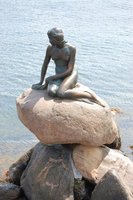
Small Little Mermaid
© sfoshee
- Location: Copenhagen, Denmark
- Erected: 1913
- Height: 1.25 metres
One of the most recognisable landmarks of Copenhagen is the statue of the Little Mermaid. It is situated in the harbour of the city, which means it's a pretty long walk (30-45 minutes) from the center of Copenhagen to the statue. If you don't feel walking that far, note that most of the channel tours have a route that takes you along the statue. The statue was placed in Copenhagen in 1913, as a gift from Carl Jacobsen, who was impressed by the performance of the little mermaid that he had seen earlier. The statue was made by Edvard Eriksen. The face of mermaid is that of Ellen Price, who had the lead role in the ballet that Carl Jacobsen had seen. However, it was the body of the sculptor's wife, Eline Eriksen, that was used as the ballerina did not agree to model in the nude. The statue in the harbour is a copy, of an original that is stored in a secret location. For good reasons as the one in the harbour has been vandalised several times.
Manneken Pis
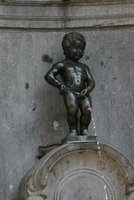
Manneken Pis, Brussels
© timnz
The record for the smallest statue in this list goes to: Manneken Pis (Little peeing man) of Brussels. The statue that we see today was placed in 1619, and crafted by Jerome Duquesnoy. It replaced a statue that had stood on the same place, with a similar statue that was made of stone, and that had stood there since the Middle Ages. Over the years, the statue had been stolen no less than 7 times. On some days the little guy is peeing beer, which is served to the people that are passing by. Another custom is to dress up the little guy - published schedule of the costume change can be found posted on the railings of the fountain. He has collected an impressive wardrobe during the years, many permanently exhibited at the City Museum. The statue can be found on the crossing of the Stoofstraat and the Eikstraat (or in French: Rue de l'Étuve and Rue du Chêne). It is possible to come across more similar statues in Belgium and even Brazil, of which the one in Geraardsbergen is involved in the dispute to claim the title as the oldest Mannekin Pis. Since 1987 there has also been a female counterpart, called Jeanneke Pis, located on the east side of the Impasse de la Fidélité/Getrouwheidsgang.
Mother Albania
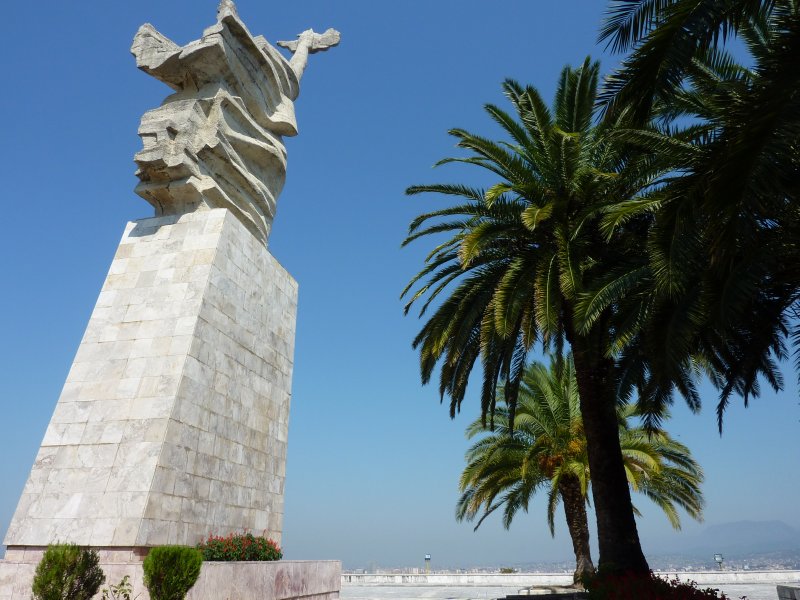
Mother Albania watches over Tirana
© Utrecht
Mother Albania is a statue of about 12 metres high and is located at the National Martyrs Cemetery of Albania, in the capital Tirana. The statue, erected in 1971, represents the country as a mother guarding over those who gave their lives for her. There are 28,000 graves of Albanian partisans in the cemetery behind the statue, all of whom died during World War II. The massive statue holds a wreath of laurels and a star. The cemetery initially also was the last resting place of former leader Enver Hoxha, but he was given a more humble grave in another public cemetery afther the fall of the Communism and the end of Albania as a closed country as well. It is a concrete statue is a work of the sculptors Kristaq Rama, Muntaz Dhrami and Shaban Hadëri. It stands on top of a 3-metre-high pedestal, on which are engraved the words "Lavdi e perjetshme deshmoreve te Atdheut" (Glory to the martyrs of the homeland forever).
Peter the Great statue
In the years since it was unveiled the opinions about the Peter the great statue have been very mixed. It was voted as ugliest statue in 2010, and listed amongst the ten ugliest buildings. The people of Moscow can add to that, that they don't want to pay tribute to the man that moved the capital of Russia from Moscow to St. Petersburg. It is located on the western confluence of the Moskva River and the Vodootvodny Canal in downtown Moscow. It was designed by the Zurab Tsereteli to commemorate 300 years of the Russian Navy, which Peter the Great established. It is reported that the local government in Moscow, offered the statue to be relocated to St. Petersburg, but the offer was rejected, and for this moment this (in)famous statue is still on display.
Rodina-Mat Zovyot!
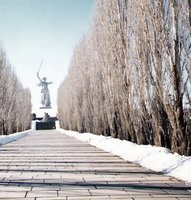
Mamayev Kurgan
© ilyushin
Rodina-Mat Zovyot! (translated: The Motherland Calls!) built by Yevgeny Vuchetich is a symbol of Volgograd. The statue was erected at the height of Mamayev Kurgan, as a monument dedicated to the victims of the battle of Stalingrad. The figure of the woman stands 52 meters high, and the sword that she holds is 33 metres. A native of the city, Valentina Izotova, posed for the statue. The statue stands on a platform that has 200 steps leading up to the actual statue. The 200 steps are symbolic for the 200 days that the siege lasted. At the time of erection it was the tallest statue in the world. The statue is held in place by its weight and not fixed to its foundations. Over the years, changes to groundwater level had caused movements to the foundations and the statue is currently leaning at a precarious angle with a tilt of an estimated 20 centimetres (8 inches). If the tilt continues by just a few more centimetres before corrective measures can be put in place, it will most likely collapse.
Stalin Monument
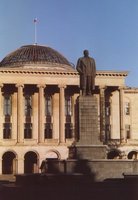
Stalin in his birthplace Gori
© Utrecht
Although there were quite a few statues of Lenin throughout most of the former Soviet Union states, the Stalin Monument in Gori, Georgia, is probably the last one still standing. Gori was the birthplace of Iosif Vissarionovich Dzhugashvili, better known as Joseph Stalin. Apart from the 12-metre-high statue, which is located on the main square in front of the City Hall, there is also a Stalin Museum which sections include one of his trains and a house where he was born. The open exhibition of links to Stalin is not without controversy in the independent Georgia. While the statue has been left untouched following its survival from Khrushchev's de-Stalinization program, in August 2009, it was announced that the statue will be relocated to the Stalin Museum, which finally was done in June 2010. In its place, a monument to commemorate the soldiers who was killed by Russian cluster bombs in 2008, right in front of the undamaged statue, is due to be erected. Additionally, there is also a plan to reorganise the Stalin Museum into Museum of Russian Aggression in the near future. On a side note: there also is a small Stalin Museum in Batumi along the Black Sea coast of Georgia.
The Thinker
The Thinker (Le Penseur) is a bronze and marble statue that was crafted by Auguste Rodin in 1902. Before making this statue, a couple of smaller versions were made. The first plaster version was made in 1880, but it wasn't until 1902 that the first large-scale bronze cast was completed. The statue depicts a man who is thinking, or in meditating state. The statue was originally named The Poet, as it should be depicting a meditating Dante in front of the Gates of Hell, pondering his great poem. The Thinker was the first statue by Rodin that was placed in the public space. First presented in 1904, it became the property of the city of Paris and despite the initial intent of this commission to be part of a monumental portal of Musée des Arts Décoratifs, it was put in front of the Panthéon in 1906. It was moved in 1922 to the present place: the Hôtel Biron, which houses the Museé Rodin since 1919. Over the years a lot of casts has been made of the statue, which contributed to the popularity of the statue.
Venus de Milo
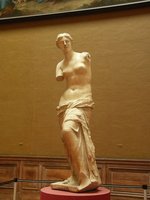
Venus
© davidb
The Venus de Milo is an ancient Greek statue made of marble, which is assumed to depict the Aphrodite, the Greek goddess of love and beauty. Therefore she is also known under the name the Aphrodite of Milos. The statue was found at the ruins of the city of Milos, on the Island of Milos. At the time of the discovery of the statue a French naval officer happened to be on the island, and uncovered the statue together with its finder, who eventually sold the statue to the French. It was already sold to Turkey, but the French ambassador arrived just in time to persuade the seller to sell it to the French. The statue was found in two large pieces, and a couple of smaller pieces including the left arm, holding an apple. Upon arrival in the Louvre it was however agreed that the left arm was from a later restoration. Also the plinth that came with the statue was dismissed as being authentic, as by that time most the 'experts' believed the statue was crafted by Praxiteles, but the plinth told them differently, and spoke of (Alex)andros son of Menides being the creator of the statue. Just before the statue was presented to Louis XVIII, the plinth disappeared and was never recovered.
Winged Victory of Samothrace
Also known as Nike of Samothrace, the Winged Victory of Samothrace is a Greek marble sculpture that has been prominently exhibited at the Louvre since 1884 atop the Daru staircase. The sculpture originally formed part of the Samothrace temple complex. This beautiful Hellenistic sculpture is believed to be created in honour of the Goddess of Victory but also to honour a sea battle, most likely the naval victory by Rhodes which at that time was the most powerful maritime state in the Aegean (this evidence indicated by a partial inscription on the base of the sculpture, including the word "Rhodhios"). The Victory, despite its significant damage and incompleteness, exhibits a true naturalistic pose with fine rendering of its draped garments. Its outstretched wings are symmetrical, and with the loss of the head and the arms, in a way act to enhance the statue's depiction of power and pride. The sculpture of the complete Victory was of Nike with her right arm raised to a cup around her mouth in the delivery of the shout of victory. While the head and the arms have never been found, other fragments including the right hand and some fingers have been recovered on separate excavation expeditions, and have since been reunited and displayed in a glass case adjacent to the podium where the status stands.
North America
Crazy Horse Memorial
- Location: Black Hills, South Dakota, USA
- Erected: 1948-???
- Height: 172 metres (planned)
This monument depicts Crazy Horse, a Native American warrior of the Oglala Lakota tribe. It shows him riding a horse with left arm extended and index finger pointing into the distance towards "his lands". It is carved on Thunderhead Mountain on land sacred to some Native Americans. Works started in 1948 and has yet to be completed. So far the most notable part of the statue is the face which was completed in 1998. The most emphasis since the completion of the face lie on the carving of the horse's head. The most rudimentary removal of rocks is done by placing explosive in the mountain. The project is entirely funded by private donations as the builders refused funding from the US government. A glimpse of how the project might end can be seen here.
Lincoln Statue
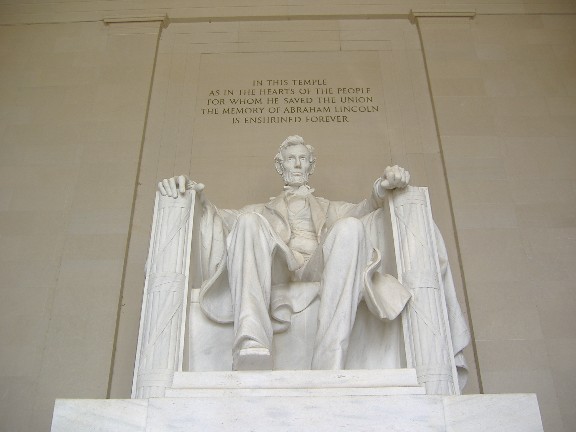
Lincoln Memorial, Washington, DC, USA
© GregW
- Location: Washington, D.C., USA
- Erected: 1914 - 1922
- Height: 6 metres
Abraham Lincoln is the only person to appear on this list two times, as he is also one of the four presidents at Mount Rushmore (see below). The statue is part of the Lincoln memorial. The first plans for the memorial date back to 1867 when a commission was formed to work out plans for a memorial in honour of Abraham Lincoln, but the build was not commissioned until 1911, as a suitable piece of land couldn't be found before 1902.
The first stone of the memorial was laid on 12 February 1914, the birthday of the president. While Henry Bacon worked on the memorial, Daniel Chester French designed the statue of Lincoln, which would become the centre piece of the memorial. The statue is made from white marble carved by the Piccirilli Brothers in New York, and looks towards the reflecting pool and the Washington monument in the distance.
Mount Rushmore
- Location: Keystone, South Dakota, USA
- Erected: 1927–1941
- Height: four figures each 60 metres (1,745 metres above sea level)
Mount Rushmore is an iconic monument to US political history and is carved into the side of a solid granite mountain. It consists of the faces of four famous US presidents. They are George Washington, Thomas Jefferson, Theodore Roosevelt and Abraham Lincoln. In fact the statue is a compromise as the original design also included the upper bodies of the presidents. The design is by Gutzon Borglum, who also was the supervisor on the project, but it was his son Lincoln Borglum, who finished the project in 1941, which is also the year in which his father died. There is a visitor center, named after Lincoln Borglum near the mountain, where more information about the construction of the monument can be found. In the evening Mount Rushmore is illuminated for two hours after sunset.
Statue of Liberty
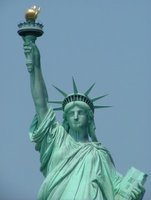
Statue of Liberty
© twokiwis
- Location: Liberty Island, New York, USA
- Erected: 1886
- Height: 46 metres (93 metres including the pedestal)
One the most famous pictures in the world is the image of the Statue of Liberty. It is not only an icon for New York but also for the nation. The statue was a gift from the French people to celebrate the centennial of the Independence of the United States. The statue was constructed in France, and after completion shipped to the USA, where it was stored for 11 months, to await the completion of the pedestal. It was finally unveiled in November 1886.
Liberty Island is open to only 15,000 visitors each day, and only 3,000 passes a day are available for the crown section of the statue.
Two smaller statues predates the statue that is placed in New York. One stands in Paris in the Jardin de Luxembourg, and a second stands in front of the city hall in Maceió, in Brazil. After the success of these statues, it was decided to go huge. Nowadays copies of the Statue of Liberty can be found all over the world, including the one in Las Vegas in front of the New York New York hotel.
Oceania
James Cook Statue
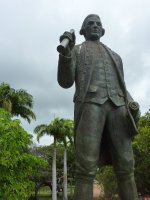
James Cook statue, Cooktown
© Utrecht
- Location: Cooktown, Queensland, Australia
The James Cook Statue is located in Cooktown, in Northern Queensland. BP Australia donated the James Cook Statue to the people of Cooktown. The bronze statue is the work of the Australian sculptor Stanley Hammond. A large granite rock on the foreshore bears a plaque with the inscription "This cairn marks the spot where Captain James Cook beached his barque HMS Endeavour in the year 1770". The statue is located in Bicentennial Park, the pleasant but small park in Cooktown along the entrance of the Endeavour River.
South America
Christ the Redeemer
- Location: Rio de Janeiro, Brazil
- Erected: 1930
- Height: 30 metres (38 metres including the pedestal)
The most famous statue of South-America stands on the 700-metre high Corcovado mountain, overlooking Rio de Janeiro. The first idea to erect a huge statue dates back to 1850, but the statue of Christ the Redeemer was not erected until 1930. From the platform at the foot of the statue you have a great view over the city of Rio de Janeiro, both to the north and the south, as the city curves itself around the Corcovado. From the city there is a red train going up the mountain, making it the easiest way to reach the statue.
Moai's
- Location: Easter Island (Rapa Nui), Chile
- Erected: unknown
- Height: varying
The 887 Moai statues that stand and lie on Easter Island are the most famous picture that most people have from this remote island, that lies some 3,600 kilometres off the coast of Chile. Sometimes mistakenly called the heads of Easter Island, the statues are in fact complete torso's. When the statues where made is unclear. Some estimates date them between 1250 and 1500 AD. Other theories date the oldest ones at around 400 AD. What is known is that the statues were made by hand, with stone tools. The tallest standing statue is about 10 metres tall, but the largest statue that was never erected, would have been the tallest with 21 metres. Some of the Maoi's had, and still have a Pukoa on their heads. During the seventies it was discovered that the statues had eyes, made of coral for the white part, and a black obsidian for the iris, after the discovery many of the restored statues are fitted with eyes.
La Virgen de Quito
On the 200-metre high hill of El Panecillo, stands La Virgen de Quito, the statue of the Virgin Mary. Due to its location the statue can be seen from most of Quito. The statue is made out of approximately 7,000 pieces of aluminium, and was made by the Spanish artist Agustín de la Herrán Matorras. He was commissioned to build a 41-metre-high monument of the Madonna, and completed his work in 1976. He based his statue on a statue by Bernado de Legarda, who sculpted his "Virgen de Quito”, a 30-centimetre-high sculpture in 1734. The statue was unveiled and inaugurated on the 28th of March 1976 by the Archbishop of Quito.
Contributors
 Utrecht (44%)
Utrecht (44%)
from https://utrecht.travellerspoint.com Herr Bert (38%)
Herr Bert (38%)
as well as Hien (12%), hasbeen (2%), Peter (1%), dr.pepper (1%), Q' (1%), Sander (<1%)
Famous Statues Travel Helpers
We don't currently have any Travel Helpers for Famous Statues
This is version 115. Last edited at 8:48 on Dec 6, 19 by Utrecht. 18 articles link to this page.

Except where otherwise noted, content of this article is licensed under a Creative Commons Attribution-ShareAlike 3.0 License



